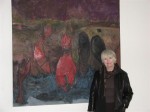Art from 19th-century South Carolina
The expressions of slaves of West African origin on view at the Milwaukee Art Museum.
Dimensions is the Milwaukee School of Engineering (MSOE) magazine. I saw in the Spring 2012 issue that the school, with the assistance of Oregon-based artist Brian Gillis, helped create a time capsule (“Of Ghosts and Speculation”) of a face jug. You’ll find it at the Milwaukee Art Museum, in Face Jugs: Art and Ritual in 19th-Century South Carolina. The exhibition runs through through Aug. 5 in the Kahler wing (which I will forever think of as the “old museum” tacked onto the winged Calatrava addition). The show resides in the Chipstone area on the lower level, adjacent to a lovely collection of American paintings. (In the old days, when the Kahler addition was relatively new, I heard many a lecture in the area that currently features assorted chairs. They were often hilariously punctuated by flushing sounds emanating from the two restrooms directly to the south.)
Time marches on and, indeed, the time-capsule face jug is just the right choice for an exhibition focused on timeless items made by 19th-Century slaves of African heritage.
The South Carolina slaves who fashioned the jugs gave them “faces” with African-American features: plump lips, bulging eyes, etc. “An Aesthetic Darkey,” a stereoscopic image from 1882, is intentionally racist, but it takes a swipe at a very white Irish writer and poet, Oscar Wilde. The handsome booklet accompanying the exhibition is careful to note that the “jugs themselves were not intended to be racist representations,” and it’s speculated by historians that they were perhaps satirical and ritual in nature. I note here that the touring show will open the Birmingham (Alabama) Museum of Art Jan. 13. If you’re old enough, you’ll recall that Birmingham was the site of early civil rights demonstrations. There’s irony (and perhaps guilt) to know that next year the jugs are marching into Birmingham, where a bloody blast in 1963 killed four children
The aforementioned booklet has a fold-out page of 18 images of the face jugs. Their Alkaline glazed expressions vary from frightened to happy to questioning. The colors of their faces range from dark-as-night to a shade I’ll call “almond,” but this may have had more to do with the color of the available clay than with the color of the skin of the maker. One is a face cup, another is a face pitcher, but all the images are accompanied by notations about when they were made.
To my eyes, the teeth fascinate the most, be they missing or intact, sharpened or not, their white kaolin presence is hard to ignore. Curated by Claudia Mooney and designed by Mike Mikulay (with booklet design by Dan Saal), this is a small elegant offering to our city which has had its share of racial tension. I’m wondering what those 19th-Century slaves would feel had they lived to see President Barack Obama boarding Air Force One?
Previous story: Potter Michael Bayne at MAM.
Art
-
It’s Not Just About the Holidays
 Dec 3rd, 2024 by Annie Raab
Dec 3rd, 2024 by Annie Raab
-
After The Election Is Over
 Nov 6th, 2024 by Annie Raab
Nov 6th, 2024 by Annie Raab
-
The Spirit of Milwaukee
 Aug 30th, 2024 by Annie Raab
Aug 30th, 2024 by Annie Raab

























Did you go to the exhibit? I was there and am concerned with your lack of insight and observation. Please elaborate your full views going forward.
Thank You,
MM
MM: I visited the exhibit twice, but perhaps you’d lend me the insight you feel I’m lacking?
[…] Sources: Birmingham Museum of Art, Metal Powder Report, Melodika, TCD […]
Judith,
Ignore the comments of MM. Face jugs of South Carolina have gotten to be a topic that can fill volumes. There is still much research to do and a newspaper article can only give so much information and not seem like a graduate research paper. You did well with your article! Kudos! I spent 8 hours at a symposium in December and would have sat through another 8 hours. I have a passion for the history and love making them as well!
Debbie